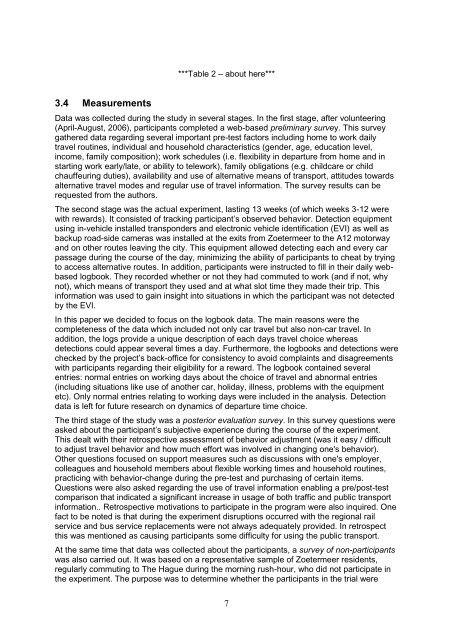Ben-Elia, E. and Ettema, D. (2011) Changing commuters' behav- ior ...
Ben-Elia, E. and Ettema, D. (2011) Changing commuters' behav- ior ...
Ben-Elia, E. and Ettema, D. (2011) Changing commuters' behav- ior ...
You also want an ePaper? Increase the reach of your titles
YUMPU automatically turns print PDFs into web optimized ePapers that Google loves.
3.4 Measurements<br />
***Table 2 – about here***<br />
Data was collected during the study in several stages. In the first stage, after volunteering<br />
(April-August, 2006), participants completed a web-based preliminary survey. This survey<br />
gathered data regarding several important pre-test factors including home to work daily<br />
travel routines, individual <strong>and</strong> household characteristics (gender, age, education level,<br />
income, family composition); work schedules (i.e. flexibility in departure from home <strong>and</strong> in<br />
starting work early/late, or ability to telework), family obligations (e.g. childcare or child<br />
chauffeuring duties), availability <strong>and</strong> use of alternative means of transport, attitudes towards<br />
alternative travel modes <strong>and</strong> regular use of travel information. The survey results can be<br />
requested from the authors.<br />
The second stage was the actual experiment, lasting 13 weeks (of which weeks 3-12 were<br />
with rewards). It consisted of tracking participant’s observed <strong>behav</strong><strong>ior</strong>. Detection equipment<br />
using in-vehicle installed transponders <strong>and</strong> electronic vehicle identification (EVI) as well as<br />
backup road-side cameras was installed at the exits from Zoetermeer to the A12 motorway<br />
<strong>and</strong> on other routes leaving the city. This equipment allowed detecting each <strong>and</strong> every car<br />
passage during the course of the day, minimizing the ability of participants to cheat by trying<br />
to access alternative routes. In addition, participants were instructed to fill in their daily webbased<br />
logbook. They recorded whether or not they had commuted to work (<strong>and</strong> if not, why<br />
not), which means of transport they used <strong>and</strong> at what slot time they made their trip. This<br />
information was used to gain insight into situations in which the participant was not detected<br />
by the EVI.<br />
In this paper we decided to focus on the logbook data. The main reasons were the<br />
completeness of the data which included not only car travel but also non-car travel. In<br />
addition, the logs provide a unique description of each days travel choice whereas<br />
detections could appear several times a day. Furthermore, the logbooks <strong>and</strong> detections were<br />
checked by the project’s back-office for consistency to avoid complaints <strong>and</strong> disagreements<br />
with participants regarding their eligibility for a reward. The logbook contained several<br />
entries: normal entries on working days about the choice of travel <strong>and</strong> abnormal entries<br />
(including situations like use of another car, holiday, illness, problems with the equipment<br />
etc). Only normal entries relating to working days were included in the analysis. Detection<br />
data is left for future research on dynamics of departure time choice.<br />
The third stage of the study was a poster<strong>ior</strong> evaluation survey. In this survey questions were<br />
asked about the participant’s subjective experience during the course of the experiment.<br />
This dealt with their retrospective assessment of <strong>behav</strong><strong>ior</strong> adjustment (was it easy / difficult<br />
to adjust travel <strong>behav</strong><strong>ior</strong> <strong>and</strong> how much effort was involved in changing one's <strong>behav</strong><strong>ior</strong>).<br />
Other questions focused on support measures such as discussions with one's employer,<br />
colleagues <strong>and</strong> household members about flexible working times <strong>and</strong> household routines,<br />
practicing with <strong>behav</strong><strong>ior</strong>-change during the pre-test <strong>and</strong> purchasing of certain items.<br />
Questions were also asked regarding the use of travel information enabling a pre/post-test<br />
comparison that indicated a significant increase in usage of both traffic <strong>and</strong> public transport<br />
information.. Retrospective motivations to participate in the program were also inquired. One<br />
fact to be noted is that during the experiment disruptions occurred with the regional rail<br />
service <strong>and</strong> bus service replacements were not always adequately provided. In retrospect<br />
this was mentioned as causing participants some difficulty for using the public transport.<br />
At the same time that data was collected about the participants, a survey of non-participants<br />
was also carried out. It was based on a representative sample of Zoetermeer residents,<br />
regularly commuting to The Hague during the morning rush-hour, who did not participate in<br />
the experiment. The purpose was to determine whether the participants in the trial were<br />
7

















